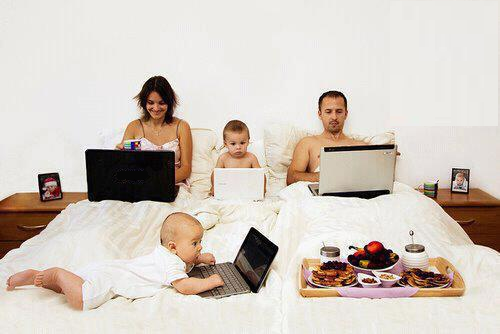 We like easy. And why not? Who would argue that convenience is a bad thing? Jumping through the past hundred years or so, it seems that almost everyone would agree that it’s better to:
We like easy. And why not? Who would argue that convenience is a bad thing? Jumping through the past hundred years or so, it seems that almost everyone would agree that it’s better to:
- Travel cross country by jet than by horse;
- Wash clothes in a machine than by hand;
- Watch a TV show when it fits our schedule rather than when a network chooses to broadcast it;
- Type and edit on a computer than a typewriter; and of course,
- Connect with anyone, anytime, by text or phone, rather than hoping they’ll be at home sitting next to a landline.
These are everyday things that most of us, especially younger people with no living memory of the terrible struggles of life before text messaging, take for granted.
But is there a downside to convenience in our lives? Tim Wu, a Professor at Columbia University, makes an eloquent case against a world where everything comes easy in his recent New York Times op-ed, The Tyranny of Convenience.
Wu points out the narcissism inherent in many modern conveniences:
Most of the powerful and important technologies created over the past few decades deliver convenience in the service of personalization and individuality. Think of the VCR, the playlist, the Facebook page, the Instagram account. This kind of convenience is no longer about saving physical labor — many of us don’t do much of that anyway. It is about minimizing the mental resources, the mental exertion, required to choose among the options that express ourselves. Convenience is one-click, one-stop shopping, the seamless experience of “plug and play.” The ideal is personal preference with no effort.
No effort, indeed. He further argues that:
Today’s cult of convenience fails to acknowledge that difficulty is a constitutive feature of human experience. Convenience is all destination and no journey. But climbing a mountain is different from taking the tram to the top, even if you end up at the same place. We are becoming people who care mainly or only about outcomes. We are at risk of making most of our life experiences a series of trolley rides.
An unwelcome consequence of living in a world where everything is “easy” is that the only skill that matters is the ability to multitask. At the extreme, we don’t actually do anything; we only arrange what will be done, which is a flimsy basis for a life.
Multitasking runs amok in the business world. Short-term thinking and relentless pressure to make the numbers every quarter have pushed head counts way down and people are just too busy to get anything done. My clients are typically in meetings all day long, leaving the hours before 9:00 AM and after 5:00 PM as the only time to tackle real work.
The pace is relentless and often dehumanizing. Their phones go off 24/7 and immediate responses are expected from their bosses. Individual offices gave way to cubicles which then gave way to long-tables in open spaces where people sit shoulder-to-shoulder with no privacy and about as much personal space as a commuter on the Tokyo subway at rush hour.

With all the buzz that “mindfulness” has been getting in the corporate world, this constant treadmill of activity and lack of privacy is at distinct odds with the ability to focus.
I have a client, someone I truly respect and with whom I enjoy working, who proudly touts her company’s philosophy: “We go at 125% speed to meet 80% of our goals.”
Shouldn’t that be the other way around? A single percentage point of annual growth or loss translates to a huge amount of money for a major brand. Wouldn’t it be more prudent and profitable to go at 80% speed, make thoughtful rather than hasty decisions, and achieve 90% to 100% of your goals?
Before a presentation to provide the results of a big study and our recommendations for that company’s biggest brand, I was warned that it was standard practice for their people to bring phones and laptops into meetings so that they could catch up on work. Therefore, I was urged to make the strongest possible impression in the first two minutes to ensure that I get their faces out of their screens.

I wondered…should I start with a song? Maybe send in a comedian to do a few minutes of stand-up to warm up the crowd?
They had originally allotted a half-hour for the meeting and requested that the entire project be summarized on one slide to facilitate discussion and spare decision makers the details. I requested two hours and responded to the one-slide request with a firm “no.” This meeting would play a major role in determining the foundational strategy of their flagship brand. The research was incredibly rich, layered and nuanced. There were stories to tell that would be critical in providing the context for the company to make critical decisions.
I got an hour and made the most of it. (And by the way, no one felt the need to text or email or swipe on Bumble. It seems that people will pay attention when we set the proper expectations, and more importantly, have something meaningful to say.)
Unfortunately, this “I have no time for thinking so please don’t make me think” modus operandi is more typical than not, and many times it extends to the entire process, not just the presentation. Another client of ours rejected a proposal last year because they had no time for travel, to strategize and ideate, or to attend focus groups. The purpose of this project was to create new concepts for a major product line that would fill the innovation pipeline for the next two years.
You would think they’d want as much direct participation as possible, given what they were going to spend on research and consulting fees, and more important, how much incremental revenue and profit the project would return over time, if successful.
But they just wanted the “answers.” Moreover, they were reluctant to rely on our people-based, creative approach. They were literally looking for some kind of automated research model that would do the work for them.
In Wu’s words, this is all destination and no journey. By taking the tram to the top of the mountain, we render the experience disposable and learn nothing in the process.
The biggest problem with these convenience-based approaches to marketing is how difficult it can become to build consensus. As challenging as it is to develop ideas, in my experience, it can be even harder to sell them through the many layers of large organizations. Individuals, departments and outside agencies will always have their own agendas, biases and egos. “Not invented here” still rules the day. The work – the ideas themselves – never matter as much as how they make the key players feel. “Your idea can’t work because I’m smarter and more senior and more creative than you, so by accepting your idea I am admitting that you are better than me and I will never let that happen.”
We see this dynamic between clients and their ad agencies all the time. Client ideas are “boring clichés” while agency ideas are “creative” and “cool.” Even if they are clearly incapable of selling anything.
The journey is important, and all key stakeholders need to be along for that challenging, sometimes painful slog up the mountain. We need to discover insights together, spend time with each other in formal business meetings and casual conversation and push marketing and creative discussions to their very limits. When these experiences are shared, the personal bonds between team members grow strong, forming a powerful, united front. The confident, consistent, unflinching direction that arises then send strong signals to management and everyone else in the organization to get behind the team’s recommendations.
There are no shortcuts, no black box models, no automated processes that can replace the human interactions required to build consensus. We know we’re successful when we get to the end of the process, present conclusions and recommendations to key stakeholders, and everyone smiles and says, “Of course.”
My own “brilliance” and that of my company, I hate to admit, plays only a small role here. It’s always the shared journey that’s responsible for the depth and quality of the work. More important, it’s the strength and power of consensus around the recommendations that turn concepts into effective, revenue generating executions.



